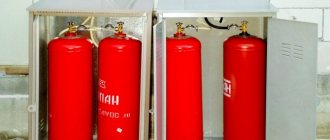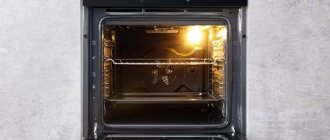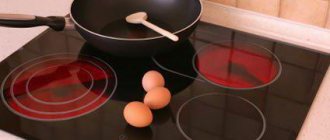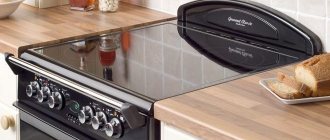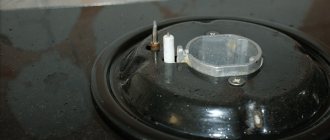What is the process of induction?
To better understand the prerequisites for the emergence of such an opinion that an induction furnace can be dangerous for the human body, it is necessary to understand what the operating principle of the device is and what exactly can cause mistrust. First of all, you need to know that the electromagnetic induction mechanism has long been used in industry for melting and heating metals, and the first model for the home was proposed in 1987. The main feature of induction models is the absence of heating elements . If a gas stove makes water boil in a kettle by burning blue fuel, and an electric stove directs electricity to heat the burners, then the glass-ceramic surface of induction devices does not heat up. All energy goes directly into the dishes, which must be made of ferromagnetic alloys.
Instead of heating elements, inside the innovative models there are induction coils, to which alternating currents of medium frequency are supplied within the range of 20 kHz - 100 kHz. As a result, a magnetic field is created. Its vortex flows pass through the glass-ceramic panel and are transferred to a frying pan, saucepan or saucepan installed on top. As a result, in dishes made from materials with high heat loss coefficients, the resistance increases and magnetization reversal processes begin, which causes strong heating and the release of thermal energy. Thus, it is not the hob that heats up, but the dishes. The surface of the stove becomes hot even from the bottom of the heated kitchen utensil.
Important! Another feature of these cookers is that induction can affect the operation of other electronic devices.
Experts do not recommend placing ovens under the hob that are not intended for such a location - suitable models must be equipped with a forced cooling system.
Myth No. 5. Induction cooker consumes too much electricity
There are several types of electric burners. And of all types, induction ones have the highest efficiency. Other burners operate on the principle of transferring thermal energy from the bottom up - from the heating element to the surface of the burner, and then to the cookware. In an induction hob, heat from the induction coil is transferred directly to the cookware, bypassing the surface. An induction hob operates without unnecessary heat loss, due to this its efficiency is much higher - up to 90%.
A few numbers for understanding. It will take about 10 minutes to heat 2 liters of water on a regular electric stove, and about 8 minutes on a gas burner. An induction hob will heat the same volume of water in just 5 minutes.
Dangers of exposure to household induction cookers
As a rule, it is precisely because of a number of requirements and restrictions imposed on the installation and use of induction cookers that potential buyers have concerns that such devices may be harmful to human health. Of greatest concern is the magnetic field generated by the device and the associated radiation.
Electromagnetic field
A wary attitude towards induction hobs is due to the well-established opinion that the electromagnetic field has a negative effect on the body and can increase fatigue, susceptibility to stress and depression. Opponents of induction cookers cite as evidence the fact that high-voltage lines create fields that are dangerous to human health, which is why there are regulations regulating the installation of power lines away from residential premises. However, unlike the high-frequency fields they create, the field generated by the hob is low- and medium-frequency. Moreover, most of the energy is absorbed by the stove itself.
On a note! It is also worth noting that many household appliances, including microwaves, smartphones and televisions, create a similar field during operation.
Radiation and Radiation
Some consumers believe that since food on an induction stove should be cooked in a special container, the properties of which are enhanced by manufacturers by pressing ferromagnetic plates into the bottom, some of the radiation enters the food and, consequently, the body. However, most pots and pans used in any kitchen have ferromagnetic properties. It’s easy to check this statement: if a magnet sticks to the bottom, then this is a cookware suitable for induction cookers.
Induction cooktops are not radioactive. During operation, the device creates electromagnetic fields that are absorbed by the device itself, and at a distance of only 30 cm from the stove, radio frequency radiation decreases to zero values .
How to reduce harm from an induction cooker?
To minimize harm from using slabs, the following rules must be observed:
- The utensils used for cooking must correspond to the size of the burner - a prerequisite is full coverage of the marked diameter. You cannot place containers with a smaller bottom area on the burner.
- All kitchen utensils are placed clearly in the center according to the markings. The bottom should not move to the side.
- When choosing cookware, the optimal size of the bottom should not greatly exceed the area of the burner. This will become an obstacle to heat removal, and as a result, the high heat protection sensor will turn off the burner.
- All utensils used must have a flat bottom. You need to check the fit of the bottom to the hob.
- When purchasing frying pans, pots and other items, check the label “For induction cookers”. Only special cookware can ensure proper distribution and absorption of thermal energy from the bottom of the product. You can check the bottom in the store for attractive properties (like a magnet). If a small magnet is actually held under the bottom, such cookware can be used for induction cookers.
- The minimum permissible distance during operation of the panel is 10 cm to the outer edge of the burner.
- Heart patients with pacemakers should seek medical advice before using the stoves.
- If you use outdated models, you need to limit the use of iron products (ladles, spoons) for stirring. Modern plates have a layer of graphite to provide a “screen” effect against leakage currents.
On a note! You need to carefully check the bottom of the cookware before purchasing. Often the manufacturer provides magnetic properties by adding ferromagnetic plates. With linings, dishes do not last long. For low-quality goods, the bottom delaminates during use.
When installing the stove in compliance with all grounding rules and electrical safety standards, there is no influence of a field of half a meter to the equipment. We must not forget the principle of operation of stoves by absorbing energy by the dishes in which food is prepared.
Experts' opinions "for" and "against"
The growing popularity and spread of induction kitchen aids has led to an increase in the number of studies being conducted to evaluate the potential harm from such devices. However, the range of experiments conducted does not allow us to unambiguously describe the effect of induction cookers on human health. For example, there is no data whether the use of such devices increases the risk of complications in various diseases, including oncology. Therefore, you can find opposing assessments and reviews from doctors on whether it is safe to install an induction stove in the kitchen.
Research against
One of the first companies to conduct research and tests on induction cookers was the Japanese organization Takenori Ueda. Its employees found that at maximum power, the radiation from an induction cooker exceeds the limit set by the International Commission on Non-Ionizing Radiation Protection (ICNIRP) by 16 times, and this is the highest figure among all household appliances. However, it should be noted that the radiation standards established by the ICNIRP commission are 50 times higher than the level of excitability of nerve cells, that is, the value at which the effect on the human body becomes noticeable.
Swiss researchers from the Federal Center for Public Health (FOPH) found that higher levels of radiation are typical for portable models when compared with stationary ones. They tested several samples and found that when a portable induction cooker is operating, the radiation behaves in the following way:
- constantly exceeds the norm at a distance of 1 cm;
- when using unsuitable utensils - at a distance of 20 cm;
- when the bottom of the pan is displaced relative to the center of the burner - at a distance of 12 cm.
Advice! For those buyers who consider even such a probabilistic risk unjustified, a tabletop infrared cooker can be a good alternative.
Resolution in favor
During tests, scientists, including those working at the WHO (World Health Organization), concluded that, despite a small percentage of studies, induction cookers do not cause significant harm to health . Such conclusions were made based on the following patterns:
- the increase in radiation levels is affected by the use of inappropriate cookware, as well as its displacement relative to the center of the burner;
- at a distance of 30 cm from the stove, the radiation level drops to zero, that is, at such a distance the device can cause hypothetical harm only if they remain at the stove for a long time (more than 2 hours) to children, pregnant women and people of short stature;
- Induction may affect the operation of nearby electronic devices.
Important! The maximum safe stay time for the type of hob in question is 2 hours.
Is it harmful to health?
The Japanese were the first to start discussing the dangers of this technique, among whom this technique was actually most widespread. Of course, the issue became public and was on everyone’s lips. Many scientists processed this information, in particular, the Swiss did progressive work.
From scientific research it follows that when used correctly and competently, this technique cannot cause harm or be more dangerous than other similar devices. Of course, such recommendations apply to all equipment. Failure to comply with the instructions for use is dangerous to human health.
You must follow the operating instructions and recommendations. They must be performed as with any other household appliance. For example, you cannot heat food in a microwave oven in metal or gold-plated dishes. For fire safety reasons, it is not recommended to leave the iron on, etc. Induction cookers are no exception, just follow the manufacturer’s recommendations and there can be no harm to your health.
Of course, there are cases when technology, although to a lesser extent, can cause a negative impact on the condition of a certain category of people. These are specific cases when, due to a disorder in the body, the doctor may recommend avoiding the use of certain devices.
Operating principle
Before using an induction cooker, you need to know how it works. The induction coil is the primary winding. And the second is the kitchen utensils placed on the burner. When utensils are placed on a work surface, induction currents are created that heat the utensil. The glass surface is also heated only by the cooking utensils.
We continue to study the principle of operation of induction cookers. The ability to fully regulate the heating power is carried out in two ways: continuous and intermittent. In the latter case, the unit will turn off and on depending on the installed power. This regulation has a high speed of preparing homemade food, as noted by reviews.
Operating principle of an induction hob
The operation of an induction burner is based on the phenomenon of electromagnetic induction. The principle of its operation is similar to the principle of operation of a transformer. Under the glass-ceramic surface of the burner there is an induction coil through which a high-frequency electric current (20-60 kHz) passes. The coil acts as the primary winding. The role of the secondary winding is played by the dishes that we place on the surface of the stove. Induction currents are transferred to the bottom of the cookware and heat it. And, consequently, its contents.
It is important to understand that currents are transmitted directly to the dishes. The glass-ceramic surface does not heat up. More precisely, it heats up during the cooking process, but not from the coil, but from the hot cookware itself.
Is it harmful to use?
In fact, the appearance of the first models of induction cookers was known 25 years ago. However, most consumers did not become owners of such a useful technical device. These statistics indicate that many are afraid to purchase a stove because they believe that the technology used at the heart of its operation can harm human health.
As a result, scientists have also become interested in the issue of harm caused by stoves. There have been many studies that have not confirmed the hypothesis that cooking hobs can have serious negative effects on people's health. In order not to be unfounded, they cited a number of convincing facts proving the correctness of the conclusion.
- The resulting electromagnetic field is minimal - such an amount, other things being equal, will not cause harm to a person.
- This type of kitchen equipment has an absorbing function, so the magnetic field does not affect humans.
- The area of influence of the electromagnetic field is limited only by the cookware present on the induction cooker.
A number of experiments were also carried out in which scientists measured the radiation emitted by the electromagnetic field. It is worth noting that at 30 cm from the stove this indicator was zero.
However, people with pacemakers, defibrillators and other similar devices should be careful when using such stoves. Since induction does create an electromagnetic field, it can significantly disrupt the operation of these devices.
Of course, most technical means have disadvantages, and an induction cooker is no exception. With the appearance of the desired new item in the house, its owners may have to change their cooking utensils. It should only be metal and attract magnets, since only such dishes can interact with the electromagnetic field generated by the coils. Also, it should not be larger in diameter than the burner itself. Read more about choosing cookware for induction cookers here.
Electromagnetic induction effect
At the same time, there are a number of categories of people who need to be extremely careful when using induction cookers. These are people who have defibrillators, pacemakers and other devices. As practice shows, the operation of these devices may malfunction near induction cookers, so the purchase in case of such health problems should be approached with caution.
An induction cooker is a technical tool like any other. And it has a number of its shortcomings. It is noteworthy that to cook food on it, metal utensils must be used, which attract magnets, interacting with the electromagnetic field generated by the coils. The correct size of the cookware should match the size of the burner.
What kind of cookware can I use?
cookware with ferromagnetic properties is suitable for induction cookers , or in simple words, it is cookware made of metal that can attract a magnet.
Such dishes include:
- enameled (steel or iron);
- utensils made of ferromagnetic stainless steel;
- cast iron cookware.
However, the most important part of such a dish is its bottom . And if the bottom of the cookware is made of ferromagnetic metal or there is at least a layer of such metal in the bottom, adjacent directly to the burner, such cookware is also suitable.
Important! The bottom of the cookware must be smooth and flat to ensure maximum tight contact with the burner.
In general, of course, it is better to use cookware specifically designed for cooking on an induction stove - this will significantly increase its efficiency. Such cookware is marked accordingly, indicating compatibility with an induction cooker.
Research results
Here are the results of studies conducted by the Swiss Federal Center for Health (FOPH).
Three models of induction cookers were chosen for the study - two stationary built-in and one portable. All of them complied with the European standard for non-ionizing radiation, which determines the standard of radiation at a distance of 30 cm from the hob. True, the standard was established with absolute observance of three basic rules for the operation of induction cookers:
- Use of high quality special cookware.
- Large diameter bottom of the pan.
- Place the cookware strictly in the center of the burner.
Therefore, to obtain more objective and complete results, the experimental conditions were expanded:
- The radiation power was measured in a zone from 1 to 30 cm to the slab.
- The influence on the radiation power of such factors as the small diameter of the bottom, incorrect centering and poor-quality material of the cookware was determined.
- Data were analyzed on changes in radiation power in the case of switching on more than one heating zone.
As a result of numerous experiments, the following was found.
Radiation at a distance of 1 cm is always much higher than normal.
For special cookware (marked for compatibility with induction cookers). If the dishes were not placed in the center of the burner, or the diameter of the bottom was less than the diameter of the heating zone, then the excess of the norm was recorded up to a distance of 12 cm.
For cookware without appropriate markings and with experimental conditions identical to those described in the previous paragraph, excess of the norm was recorded up to a distance of 20 cm from the operating stove.
Also, research results have shown that the simultaneous operation of several
burners practically does not increase the power of the electromagnetic field.
Myth No. 3. The induction hob will heat up any metal objects.
What happens if you put a spoon or fork on the hob while cooking? Is there a danger of getting burned by a hot object? Manufacturers have taken care of solving this problem. Modern induction cookers are programmed with certain restrictions on the diameter of the bottom of the cookware (usually 8 or 12 cm). This is how the stove “recognizes” that the dishes to be heated have been placed on it. If the size of the item is smaller than these values, the burner will not turn on and will not heat it. Many models are equipped with special sensors - it is simply impossible to turn on such a stove without dishes. If there are small children in the family, it is better to take care of safety and buy an induction hob with such a sensor.
Cookware sets for induction cookers: what should they be?
The dishes must have a magnetic bottom. Without this bottom it will not heat up. In order not to run into defective goods, you can check the future product by taking a magnet and attaching it to the bottom. The result will not be long in coming. If the magnet sticks, you can safely take such a product.
Such utensils are made from stainless steel, cast iron, and aluminum. You should not use other steels. A special bottom for such plates is inserted into them. The price of such dishes will significantly hit your wallet.
The best manufacturers designate the cookware with generally accepted signs and what stoves it is suitable for. They also tell you whether the dishes can be washed in the dishwasher, heating, and so on.
You need to pay attention to the diameter of the cookware set for induction cookers. If it is too small, then this cookware is only suitable for gas or electric. Before using an induction cooker, be sure to look at the bottom of the pan. It should be smooth and adjacent to the surface. Otherwise, cooking will not bring joy, and such a product will not serve housewives for a very long time.
When choosing cookware sets on the Internet, you need to pay attention to the description and product cards. They contain all the necessary information and the contact number of the manufacturer’s hotline. You need to choose stores that value their reputation. It is in this case that the entire percentage of “running into” marriage is reduced to a minimum.
Myth No. 4. The induction hob gets very hot
So that these concerns do not bother you, you just need to familiarize yourself with the principle of operation of an induction burner. At the beginning of this article, we tried to describe it briefly and as clearly as possible. The induction coil only heats the cookware. The glass-ceramic surface of the stove is heated only by the cookware itself, that is, directly under the bottom of the pot or frying pan. Once you remove the cookware from the burner, the area will cool down very quickly. The rest of the surface area will always be cold. The risk of getting burned on the surface of an induction cooker is practically eliminated.
Main advantages
Compared to older electric versions of such devices, the induction cooker is considered the number one technical tool in cooking, as it has a number of undeniable advantages. It is worth noting that cooking time is significantly shortened. But the advantages of the slab do not end there.
- Waste less energy. There is no need to wait a long time for it to heat up, as is the case with conventional cast iron heating elements. You can cook as soon as the cookware hits the burner. In addition, some time after the end of cooking, the stove turns off on its own.
- Safe cooking. This aspect should be the main one when the question arises about choosing such a technical device. Surely everyone knows what burns on a stove are - in this case this is excluded. Since only the cookware heats up during operation, the burner itself remains slightly warm. After removing the dishes, they cool completely within a few minutes.
- Comfortable conditions. When using a stove, the air temperature in the room increases slightly: heat is transferred only to the dishes in the diameter corresponding to its bottom, and not to the surrounding air.
- Practical to use. This panel is quite easy to care for. It will take a few minutes to wash the device. All you need is a well-soaped rag. In case of severe contamination, a glass ceramic cleaner and a scraper designed specifically for such a surface will help.
Depending on the model of the induction cooker, there are several additional modes. For example, the owner of such a device can calmly go about his business and prepare soup. When a certain time is set, the timer works and the stove turns off on its own.
Advantages and disadvantages of induction cookers
Are there any advantages?
Induction cookers have the following advantages over traditional gas and electric:
- It takes significantly less time to prepare food , since the heating speed is much higher than that of gas and electric stoves; moreover, only the dishes are heated at a specific point, and not the burner and the air in the kitchen - and this also saves energy.
- The hotplate will not turn on if unsuitable pans are placed on it.
- Switching on is also blocked if the diameter of the bottom of the cookware is less than half the diameter of the burner.
- The stove automatically turns off as soon as the cookware is removed from the burner - this increases safety and again reduces energy consumption.
- The set temperature is maintained as as possible due to the absence of influence on the temperature sensor of flame from gas or heat from the heating element of the electric stove.
- The surface of the stove itself practically does not heat up . The maximum temperature of the burner, which is heated only by the dishes, is no more than 60 ° C, which practically reduces the possibility of getting burns to zero (this is especially true for families with small children and pets). And the burners cool down very quickly - literally within a few minutes after turning off.
- Due to the low temperature, pieces of food falling on the stove do not burn on it . This simplifies the maintenance of the stove surface, and you can forget about the unpleasant burning smell forever.
- Availability of a large number of cooking programs for every most sophisticated taste.
- The presence of the option of “transferring power between burners” - this allows you to “take away” power from one burner for a short time and give it to the adjacent (paired) burner, which significantly increases the heating intensity .
Recently, new models of induction cookers with the following additional functions have appeared on the market:
- Control knob lock as a child safety option.
- Regulating the heating intensity of the burners, which makes it possible to both cook various dishes and reheat them.
- Setting the desired temperature using a timer, which will be maintained during cooking.
- Protection against excessive heating of dishes. If the high temperature persists for a certain time, the device automatically turns off.
Flaws
Compared to the advantages, the list of disadvantages is much shorter, but for objectivity it needs to be considered.
So, the disadvantages:
- Only cookware with ferromagnetic properties is suitable for cooking . The induction cooker will not react at all to other cookware - it simply will not turn on.
- The higher the load, the greater the power consumption . Old electrical wiring may not be able to withstand the additional load on the network, and this can create certain problems - most likely, you will have to change the wiring in the apartment.
- Induction fields can negatively affect the operation of electronic devices and devices with magnetic memory. True, this negative impact will only appear in the immediate vicinity of a working stove.
- Induction cookers should not be placed above other metal appliances . In this case, the normal operation of induction cookers cannot be guaranteed.
- Induction cookers are by no means a cheap pleasure (at least for now) and not everyone can afford it.
Instructions for using an induction cooker
- Place the pan in the center of the burner and turn on the power.
- Select automatic or manual cooking mode.
- Choose an action or dish that will be prepared, for example: soup, milk, stewing, frying, barbecue.
- If necessary, during cooking you can increase or decrease the heating power.
- In manual mode, you can set the end time of cooking using the “Timer” option. Also in this mode you can set the start time of cooking (delay cooking function). If you do not use this function, the burner will turn on automatically after a while.
Sources
- https://hitech-online.ru/tehnika-dlya-kuhni/kuhonnaya-plita/induktsionnaya-vred-dlya-zdorovya.html
- https://rem.ninja/kuhnya/tehnika/vred-induktsionnyh-plit.html
- https://eko-jizn.ru/?p=15441
- https://fb.ru/article/415714/vredna-li-induktsionnaya-plita-dlya-zdorovya-otzyivyi-vrachey-kak-polzovatsya-induktsionnoy-plitoy
- https://Tehnika.expert/dlya-kuxni/kuxonnaya-plita/indukcionnaya-vred-dlya-zdorovya.html
- https://nakuhne.guru/tehnika/varochnye-paneli/indukcionnaya-plita-eto-vred-ili-polza.html
